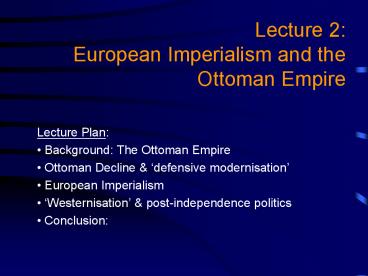Lecture 2: European Imperialism and the Ottoman Empire - PowerPoint PPT Presentation
1 / 9
Title:
Lecture 2: European Imperialism and the Ottoman Empire
Description:
1350-1918: Multi-national, -linguistic, -religious empire: ... Unifying ideology: Islam (Caliphate) & Empire ... 'national' identity could unite the Empire? ... – PowerPoint PPT presentation
Number of Views:186
Avg rating:3.0/5.0
Title: Lecture 2: European Imperialism and the Ottoman Empire
1
Lecture 2 European Imperialism and the Ottoman
Empire
- Lecture Plan
- Background The Ottoman Empire
- Ottoman Decline defensive modernisation
- European Imperialism
- Westernisation post-independence politics
- Conclusion
2
Ottoman Empire in 1856
3
Ottoman Empire in 1914
4
Ottoman Governance
- 1350-1918 Multi-national, -linguistic,
-religious empire - Majorities Christians in Balkans, Turks in
Anatolia, Arabic-speakers in Fertile Crescent,
Egypt N. Africa - Mosaic society autonomous religious millets
family/tribal fragmentation regional
decentralisation - Unifying ideology Islam (Caliphate) Empire
- Sultan-Caliph Islamic legitimation absolute
ruler central function guarantor of justice
(adala) consultatitve Diwan Grand-Vizier
firman (edicts) tax-farming mamluk army - Elites' intl origins Greeks/bureaucracy,
Christian-origin Mamluks (slave soldiers)
Turkish landed elite
5
Ottoman Decline
- European pressure internal tension ?
re-orientation of political/economic structures - Declining economic base of empire
- Western economic penetration loss of trade
routes, decline of traditional industries,
growing debt to Western capital markets (?
states) - Internal disintegrative pressures (e.g. Egypt)
- European military pressure (Rus, Aus, UK, Fra)
- Nationalism among Christian minorities in Balkans
(cf. European trends)
6
European Imperialism
- Creeping Conquest and Occupation
- dismemberment of Arabic-speaking realms by
British French over 100 years - Algeria (1830) and Egypt (1882), to post-WWI
Mandates - Settler Colonialism Palestine Algeria
- European settlement uproots peripherizes native
populations, subordinates transforms remnants
of traditional indigenous societies - Indirect control
- Egypt bankruptcy Dual Control
7
Ottoman Decline Defensive Modernisation
- Reforms (Tanzimat) strengthen without disrupting
traditional order mil.-bur. modernisation/central
isation, defend borders, ensure tax collection - Consitutionalism limit Sultan's power create
politically aware population with rights ? giv a
stake in society its defence - secular law Islam seen by some as divisive
obstacle to modernisation - military conscription, taxation standing army
- nationalism empire weak for lack of shared sense
of nationhood - Consequences
- Rise of new middle class reform requires
Western-style education/professions, ? W ideas of
modernisation, nationalism, democracy among new
middle class. - Split in Ottoman elite reformists (modern
military, bureaucrats) struggle with
traditionalists (military, religious, warlords) - military early moderniser/nationalists first
Western-educated, mission of border defence à
nationalists wanting a strong empire - Problem of Identity which 'national' identity
could unite the Empire? - Ottomanism (Muslim elite, not masses/minorities),
Islamic revival (antagonises secular middle class
Christians linked to West), Linguistic
nationalism (e.g. pan-Turkism alienates Arabs)
8
Imposition of a Western-Style State System
- WWI fragmentation into many small states
- Hussein-MacMahon (1915-16), Sykes-Picot (1916),
Balfour Declaration (1917), Treaty of Sevres
(1920) - Artificiality
- some have traditional roots consolidated by
state system Egypt, Yemen, but - others are artificial, e.g. protectorate over
Kuwait dismemberment of Syria (Syria, Lebanon,
Palestine, Jordan) - Consequences instability
- Division military-political weakness of small
feuding states - Irredentism discontent w/ 'artificial'
boundaries ? Arab nationalism aims to unite one
nation, one state (cf. European nationalism)
9
Conclusion
- European modernity economic technological
(industrial - revolution) cultural-political (nationalism,
centralisation) - Economics Industrial Revolution ? economic
initiative with Europe ? Ottoman decline
European penetration - Strategic Industrial Revolution ? European
military technology production capabilities gt
Ottoman ? shifting power balance - Ideology strong impact of European ideologies
nationalism perceived as source of unity and
therefore strength ? increasingly popular Islam
(at times perceived as obstacle) later
radicalises under continued Western dominance - Postcoloniality imperialism economics (new
economic system classes) create internal
divisions ? post-independence instability
('weak/'unfinished' states, artificial ? liable
to collapse)































